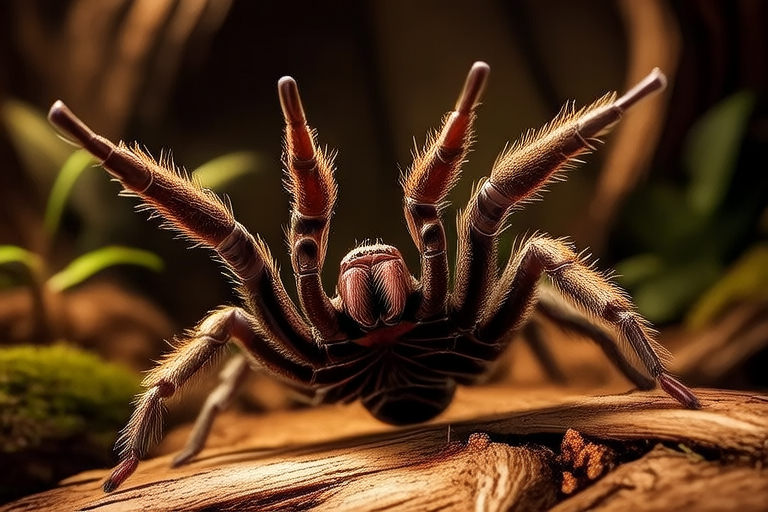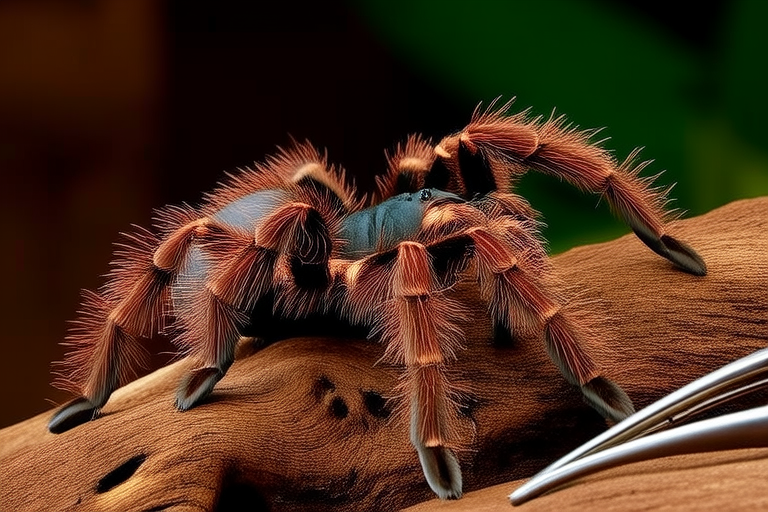
The Fascinating World of Tarantulas
Tarantulas, with their impressive size and unique behaviors, have long been objects of both fear and fascination. These arachnids, belonging to the family Theraphosidae, are found in various habitats across the globe. Their physical characteristics, diverse behaviors, and ecological roles make them a captivating subject for study and admiration.
Physical Characteristics and Diversity
One of the most striking features of tarantulas is their size. Many species can grow up to 10 inches (25 cm) in leg span, making them one of the largest spiders in the world. Their bodies are covered in dense hairs that serve multiple purposes, including protection against predators and communication. Some species, like the Chilean rose tarantula, possess urticating hairs, which they can flick at attackers to cause irritation. These hairs are a significant defense mechanism, allowing tarantulas to fend off threats without relying solely on their fangs.
The coloration of tarantulas varies greatly depending on their habitat and species. While some species are brown or black, others display vibrant hues, such as the pink toe tarantula, which has bright pink legs. This diversity in appearance reflects the adaptability of these creatures to different environments. Their legs are equipped with sensory organs that help them navigate their surroundings and detect prey or potential mates. The arrangement of these organs allows tarantulas to sense vibrations in the ground, aiding in hunting and avoiding danger.
Habitats and Geographic Distribution
Tarantulas inhabit a wide range of environments, from deserts to rainforests, showcasing their remarkable adaptability. Desert-dwelling species, such as the Mexican redknee tarantula, thrive in arid conditions where they burrow into the ground to create shelters. In contrast, tropical species, like the Goliath birdeater, reside in humid rainforests where they live in silk-lined burrows or tree hollows. The adaptability of tarantulas to various habitats is a testament to their evolutionary success.
These creatures are found on every continent except Antarctica, with the highest diversity occurring in South America, particularly in the Amazon Basin. The Amazon region is home to numerous tarantula species, many of which remain undiscovered or poorly understood. The vastness of this ecosystem provides ample opportunities for tarantulas to find suitable habitats and establish thriving populations. However, human activities, such as deforestation and urbanization, pose significant threats to these habitats and, consequently, to the tarantula populations.
Ecosystem Role and Myths
Tarantulas play a crucial role in maintaining the balance of their ecosystems. As predators, they help control insect populations, preventing overpopulation and ensuring the health of their habitats. By preying on insects, tarantulas contribute to the regulation of insect species within their ecosystems, thus maintaining biodiversity. Additionally, tarantulas serve as prey for other animals, such as birds, mammals, and reptiles, forming an integral part of food chains.
Despite their ecological significance, tarantulas have often been associated with myths and misconceptions. One of the most pervasive myths is that all tarantulas are highly dangerous to humans. In reality, while tarantulas can deliver a painful bite, their venom is generally not life-threatening to humans. The severity of a tarantula’s bite depends on the species and the individual’s sensitivity to the venom. Most bites result in localized pain and swelling, similar to a bee sting. The exaggerated portrayal of tarantulas in popular culture has contributed to these misconceptions, leading many to fear these creatures unnecessarily.
Venom, Eating Habits, and Mating Rituals
The venom of tarantulas is a complex mixture of proteins and enzymes designed to immobilize and digest prey. While their venom is potent enough to subdue insects, it is typically not harmful to larger animals, including humans. Tarantulas use their venom primarily for hunting, injecting it into their prey to paralyze or kill before consuming. The venom also plays a role in defense, although tarantulas prefer to flee rather than fight when threatened.
Tarantulas are opportunistic hunters, feeding on a variety of insects, small vertebrates, and even other spiders. They employ ambush tactics, lying in wait for unsuspecting prey to pass by their burrows or webbed areas. Once prey is detected, the tarantula uses its powerful fangs to inject venom and then drags the immobilized victim back to its lair for consumption. This predatory behavior highlights the adaptability and efficiency of tarantulas in securing their next meal.
Mating rituals among tarantulas vary between species but generally involve elaborate displays of courtship. Male tarantulas produce sperm through a process called spermatogenesis and store it in structures called spermatophores. During courtship, the male performs intricate dances or vibrates his body to attract a female. If successful, he deposits the spermatophore near the female, who then collects it and fertilizes her eggs. After mating, the female lays hundreds of eggs in a silk sac and guards them until they hatch. This nurturing behavior underscores the complexity and sophistication of tarantula reproduction.
Pet Care and Conservation Efforts
For those interested in keeping tarantulas as pets, proper care is essential to ensure their well-being. A suitable enclosure provides adequate space for the tarantula to move freely and construct a comfortable burrow. Substrate materials, such as coconut fiber or bark chips, facilitate burrowing and mimic natural conditions. Temperature and humidity levels must be carefully controlled to replicate the tarantula’s native environment, promoting healthy growth and longevity.
Feeding pet tarantulas requires a balanced diet consisting of appropriately sized insects, such as crickets or mealworms. It is important to avoid overfeeding, as excess food can lead to obesity and related health issues. Regular monitoring of the tarantula’s condition helps identify any signs of illness or stress early, enabling prompt intervention.
Conservation efforts are vital to protect tarantula populations from the adverse effects of human activities. Habitat destruction, pollution, and climate change pose significant threats to these creatures. Organizations and researchers work tirelessly to preserve tarantula habitats and raise awareness about the importance of these animals in ecosystems. Initiatives include reforestation projects, protected area designations, and educational campaigns aimed at fostering respect and understanding for tarantulas. By supporting these efforts, we can ensure the survival of tarantulas and maintain the ecological balance they help to sustain.
In conclusion, tarantulas are fascinating creatures with unique behaviors, physical characteristics, and ecological roles. Despite misconceptions and fears, these arachnids play a crucial part in maintaining the health of their ecosystems. Through responsible pet care and conservation efforts, we can appreciate the importance of tarantulas and contribute to their preservation. Embracing our curiosity and dispelling unfounded fears will allow us to fully appreciate the beauty and complexity of these remarkable creatures.





